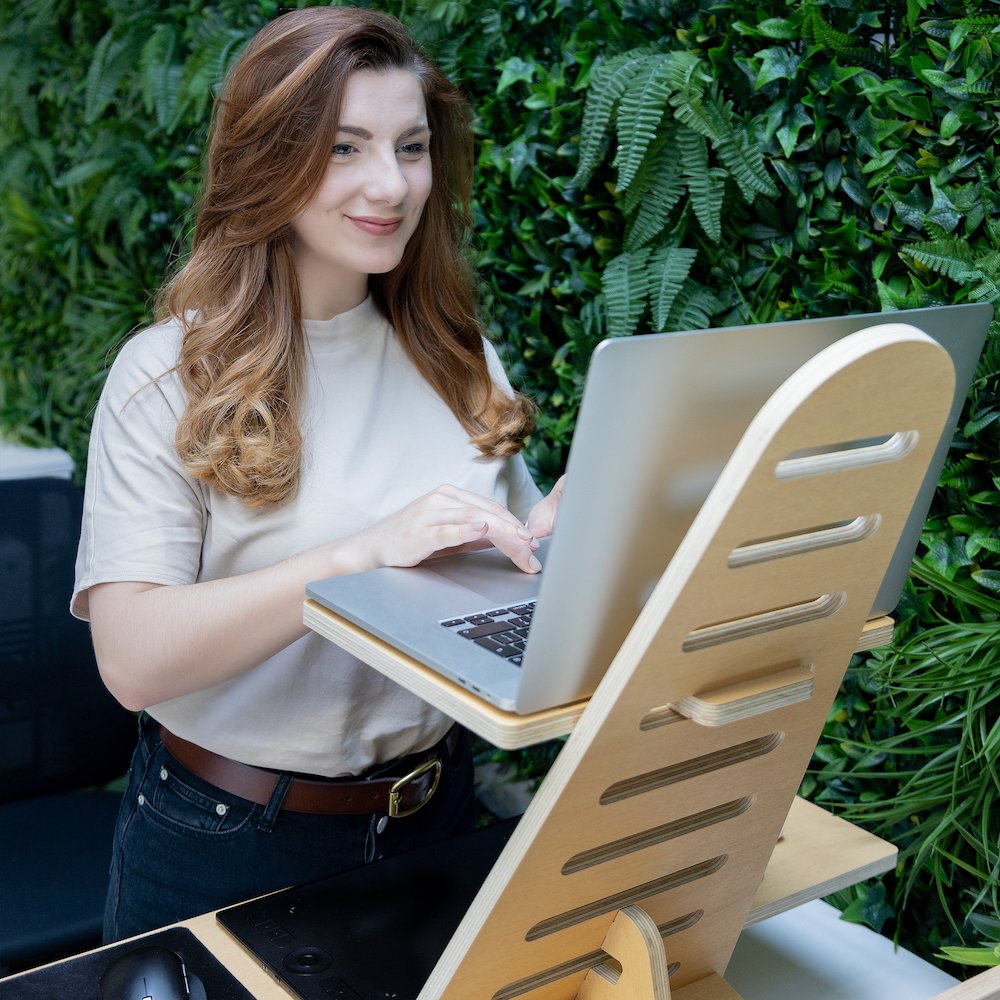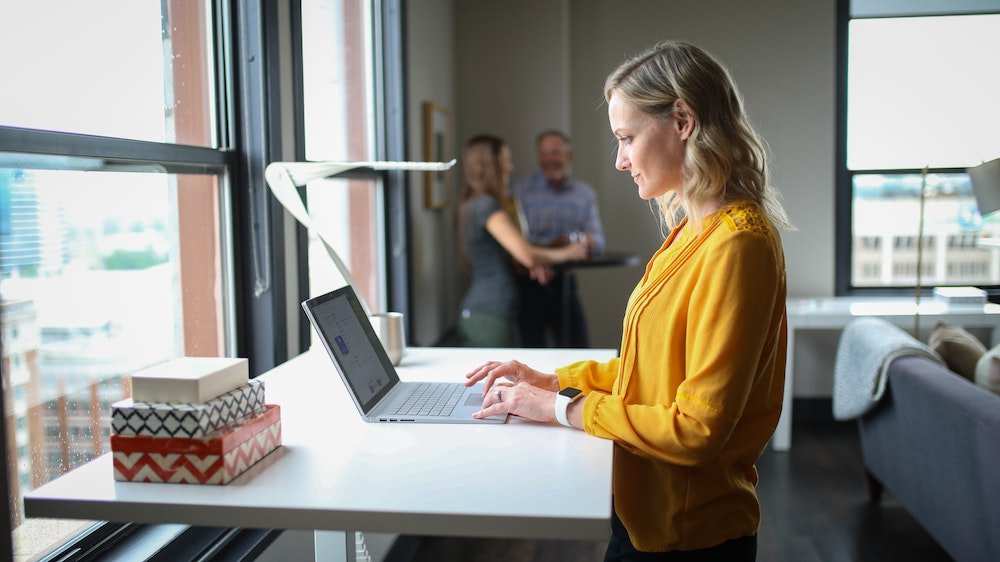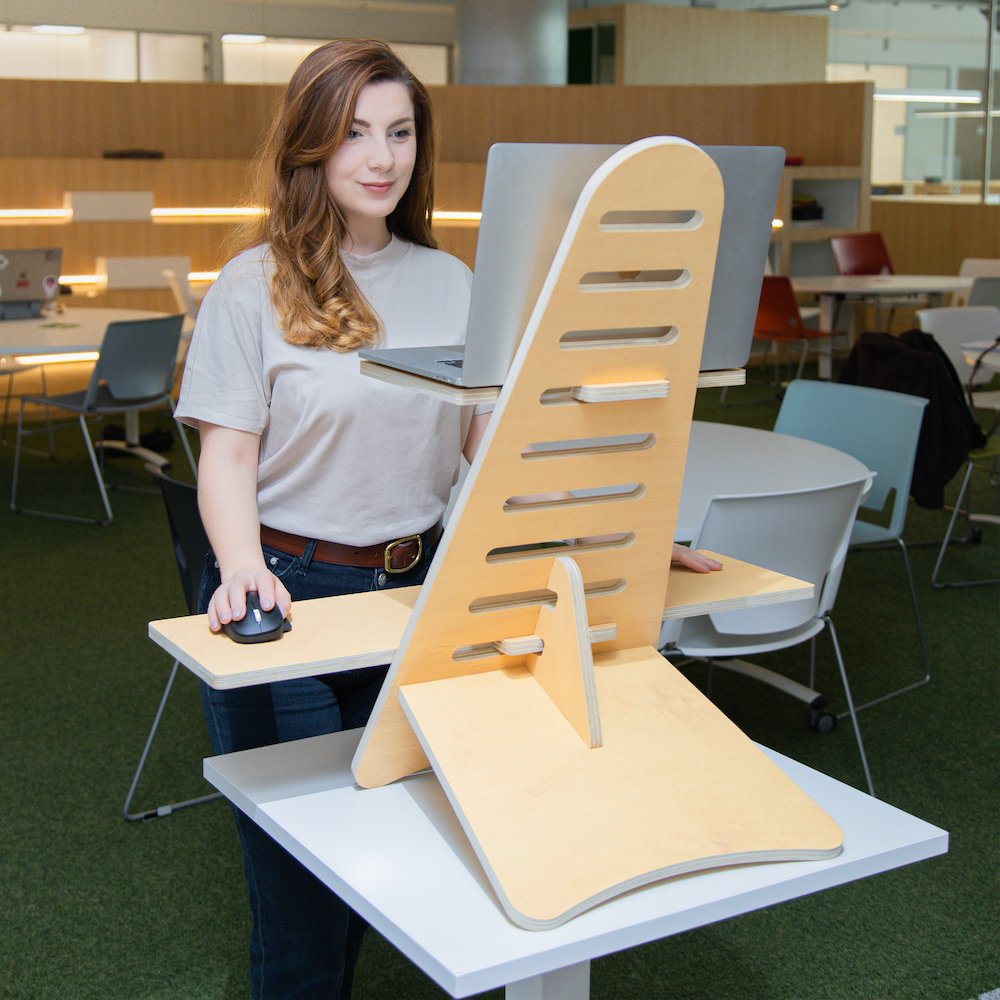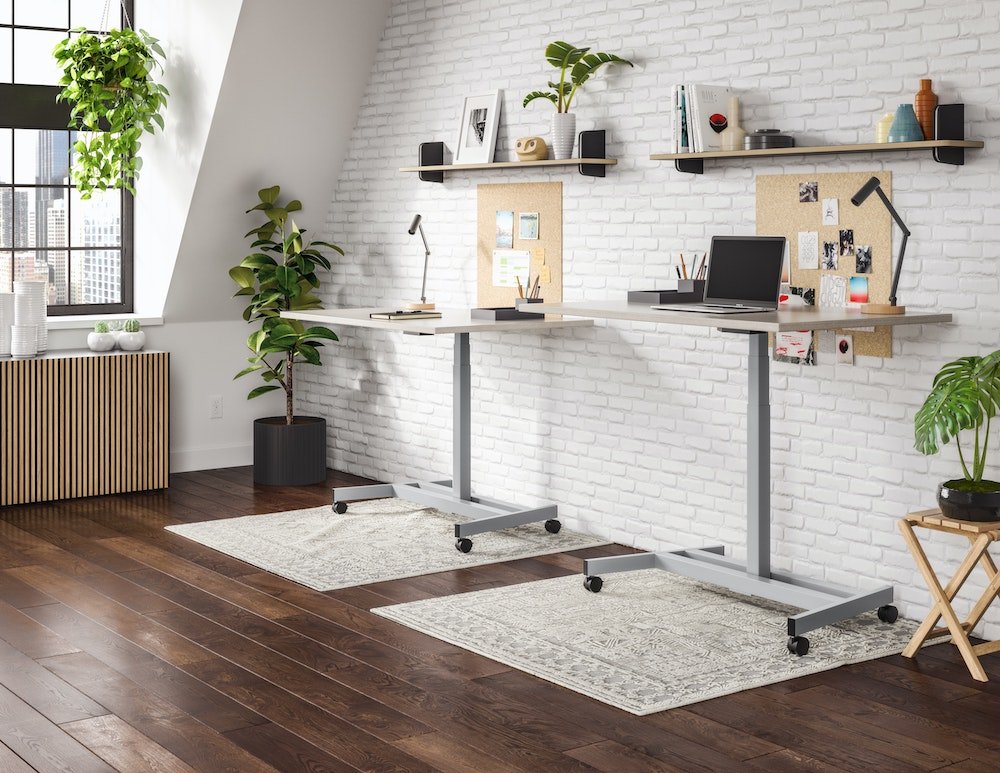Benefits of a Standing Desk: Your Health and Productivity On the Rise!
- Office
- August 17, 2021
Standing Desks have been all the rage lately. Especially since the pandemic hit and more and more people are working from home. Are you wondering what a stand-up desk even is, if they have any health benefits and if they are worth the investment? Then you have come to the right place. This article will answer all your questions about standing desks.
What is a standing desk?
The term standing desk has been thrown around a lot lately. This type of desk has actually been around for decades but it’s only recently become a popular trend. So what exactly is it? A standing desk is a physical workstation that allows the user to stand up while working. This type of workstation can be used in both personal and professional settings. The main goal of a standing desk is to enable people to stand while working and therefore shortening the amount of time they spend sitting down. This is supposed to improve health and increase energy levels. Stand-up desks usually have some sort of adjustable height feature and are designed to help improve posture, relieve stress, and increase productivity.

Why do people use standing desks?
Standing desks are used for a variety of reasons but the main goal is to spend less time sitting down. In a study done by the University of California Irvine, it was found that sitting is the most prevalent position during work hours at an average of 7 hours each day. Prolonged sitting has been shown to be harmful to health but moving between a seated and standing position can have a lot of benefits:
- Less back pain.
- Improved posture.
- Better eye health and reduced risk of developing eye diseases such as macular degeneration and glaucoma.
- Increased productivity.
- Improved concentration.
- A more active lifestyle.
- More energy and focus at work.
- Less time spent sitting.
- Saving space in the office or at home.
What is the difference between working at a standing desk vs. a regular desk?
The difference between working at a standing desk vs. a regular desk is that standing up allows for movement, whilst the sitting desk prevents this. Even though ergonomic chairs can be used to promote a healthy posture, it is very easy to slouch when sitting down. Sitting in a chair all day can also cause fatigue and lack of motivation. Since stand-up desks allow for more movement, they are able to help reduce the risk of back pain, fatigue, and other health problems. Therefore this type of desk can be a great way to improve posture and prevent back problems.
Is sitting down to work bad?
This is a question that has been debated amongst many people. There are pros and cons of both sides of the argument. Sitting down to work is not always bad, but it is important to consider what health benefits standing up during work hours can offer. Research has shown that sitting for long periods of time can lead to a range of physical and mental health issues, including obesity, back pain, poor circulation, and fatigue. This is because our body hasn’t evolved to be just sitting all day long. Sitting has also been linked to an increased risk of depression and anxiety. In addition, people who spend more time sitting have been shown to have a higher risk of cancer than those who did not sit for long periods during the day. Whilst there are many benefits to using a standing desk, people with knee problems might not benefit from a standing desk. Standing up all day may put too much strain on their knees. When using a standing desk for long periods of time, it is also advisable to use standing desk mats, which are often referred to as anti-fatigue mats. These mats are made from a shock-absorbent material, which provides relief for joints and especially the knees. Because the material is flexible, the muscles in our legs and feet constantly have to adjust. In order to do that, they contract and expand and these micro-movements significantly improve blood flow and oxygen levels in the blood.
Overall, standing desks are advisable and seem to have a better impact on our long-term health than sitting down all day. But it’s not for everyone. Some people find the idea of standing while working appalling. However, when surveying people who have been using a stand-up desk for a few weeks, they reported feeling more energized and less stressed when they stand up while working.
Can a standing desk improve productivity?
Research shows that sitting too much has a negative impact on the body and brain. When you sit in one position for hours, your blood pressure is likely to increase, which can be dangerous. Desks that are designed for standing help people work in an upright position and have more natural movement. This has also been linked to increased productivity. On average, active adults gain an hour a day in productivity due to the improved circulation and cardiovascular strength they experience from regular physical activity. The overall benefits can extend up to 13 hours per day. Studies have shown that standing desks can improve productivity by as much as 20%. One reason for this is that standing increases collaboration between co-workers, which may lead to getting things done faster. This indicates that standing desks are particularly effective in open-plan offices. Another explanation is that these desks enable their users to be more physically active, which increases blood flow and oxygen levels in the blood. When more highly oxygenated blood is pumped to the brain, it helps to think clearer, to focus better, and to work much more efficiently. Overall people who work standing up, tend to feel more awake and energized during work hours, which in turn generally leads to a greater productivity output.

Can a standing desk improve health?
There is a lot of evidence that sitting at a desk for long periods of time can lead to health problems in the long run. A standing desk may help prevent these issues by encouraging movement during the day and giving the body a break from sitting. A study by the American Journal of Preventive Medicine found that people who work standing up are less likely to have back pain and other musculoskeletal disorders. But standing up while working is not only good for your back, it also has shown to have other positive effects, such as:
- lowering the risk of heart disease
- reducing blood sugar levels (especially after lunch)
- strengthen core, leg, ankle, and feet muscles
- improving blood circulation
What are the benefits of using a Standing Desk?
We’ve already talked about a lot of the benefits of standing desks. They can be physical, psychological, or express themselves in greater productivity. Here is a summary of their benefits:
Physical:
- Reducing back, neck, and shoulder pain
- Strengthening leg and core muscles
- Reduction in blood sugar level
- Improved blood circulation
- Lower risk of heart disease
- Improved posture
- More active lifestyle
Psychological:
- Improved mood
- Reduced anxiety
- Reduced stress levels
- Improved concentration
- More energy and focus
Productivity:
- Increased productivity
- Better collaboration
- Less fatique
Do standing desks burn more calories?
People who stand for most of the day, enjoy a variety of benefits. Studies suggest that doing so can increase your average resting heart rate by 20% from its regular average – thereby burning up to 20% more calories than people who prefer sedentary work. However, there is not enough evidence to support the claim that standing burns more calories than sitting. Although there is evidence that a standing desk improves your overall health and productivity, the evidence about burning more calories is not clear.
Can a standing desk improve mental health?
A standing desk is a great way to increase productivity, reduce stress, and keep your body healthy. But can it also improve mental health? A variety of studies have shown that physical activity can also improve psychological health. But can increased mobility somehow lead to better mental health? This leads to the conclusion that physical inactivity affects psychological health. Not only is it important to commit to regular exercise, but it is also necessary to stay active throughout the day. Shifting your workstation to one that allows you to stand up, will allow you to move more naturally throughout the day, and to regularly change between a seated and standing position, could have a significant impact on your mental well-being.
Types of Standing Desks
Standing Desks can be divided into four different types:
- Fixed standing desks
- Electric standing desks
- Standing desk converters
- Portable standing desks
Fixed Standing Desks
This type of desk is fixed in height and usually can’t be adjusted. It may come in different height variations so that you can choose the right size for you. But once bought you are not able to adjust the height anymore or use it while sitting down. There generally is a limitation in the range of heights and a lot of those desks do not raise high enough, especially for taller people. The good news is, these types of desks are usually the cheapest option but they also provide the least amount of flexibility.

Electric Standing Desks
Electric standing desks come with a built-in motor, that allows you to adjust the desk height easily. You simply push a button and the desk moves up or down to your preferred height. This way you can use it sitting down or standing up. These desks usually come in a standard size as you can adjust the height to your preference. Whilst electric standing desks are very convenient, they are also quite expensive. At the same time, these desks require electricity in order to adjust the height and the motor is vulnerable to breaking. If the motor breaks you are not able to adjust the height of the desk any longer. At the same time they are often very heavy, take up a lot of space and again, don’t provide you with a lot of flexibility.

Standing Desk Converters
A standing desk converter is a construction, that allows you to make your desk a standing desk. It easily turns any surface into a standing ergonomic desk. All you need to do is to place it on top of a dining table, kitchen surface, sofa table, whatever surface you have, and tadaa, you have got yourself a stand-up workstation. These types of desks are usually easily adjustable in height, so they can adapt to the surface you are using. Standing desk converters exist with and without motors, so you can adjust the height manually or with the help of a motor. This type of desk allows for much greater flexibility than the fixed or electric standing desks as you can use it in many different situations. Converters are a great choice for offices with built-in desks and a limited amount of space for a separate standing ergonomic desk.

Portable Standing Desks
For anyone who needs maximum flexibility a portable standing desk is a great choice. They are designed to be easily assembled and disassembled so that they can be used anywhere. Portable desks are usually lightweight and are perfect for people who need to move around a lot during their workdays. This type of desk is also a great choice for people working from home as it allows them to work from different rooms in the house.

What is a laptop standing desk?
A laptop standing desk is a good choice for people who only use a laptop for work. It is a device that allows people to stand up while using their laptops. The stand is usually made out of aluminum or wood and is adjustable, so you can adjust it to your own height. This is a great concept because it allows people to utilize their laptops while standing for the most amount of time possible, with minimal breaks in between! Because they are only designed for laptops, they are usually much smaller than regular standing desks and can easily be used in small spaces or when traveling.
How to use a standing desk correctly
When using a sit-stand desk it is very important that it is being used correctly, otherwise, you could do more harm than good. Luckily it is not difficult to use a standing desk correctly.
Adjust the height of the desk correctly
To find the right height of your desk, bend your elbows 90 degrees and keep your wrists straight ahead. Now move the desk up and down until the desk aligns with your forearms and they can comfortably rest on the surface. Your wrists should never be on an incline up or down. Make sure to keep your neck neutral.
Check your posture
To prevent any discomfort keep your neck long and relax your shoulders down. Your knees should have a tiny bend when standing, do not lock your joints or overextend them. This will help to get the spine into a neutral position, where the muscles around the spine are in balance and can optimally support your body. The majority of back pain results from sedentary lifestyles and bad postures, which is why standing while working and regularly checking in on your posture are one of the best things you can do for your overall well-being.
Adjust the height of your screen correctly
The correct position of the screen is very important. Ensure that it is at eye level and not too close to the face. A good tip is to ensure the top third of your monitor is at eye level as this way you don’t have to bend your neck up to view anything on your screen. It is advisable to incline your screen by 10-20 degrees. This will also help you avoid bending your neck. In order to prevent eye strain, you should also avoid a single light source that leads to glare on your screen.
Do I need to stand all day to get a benefit from a standing desk?
The short answer is no. Sitting all day has been proven to be bad for your health. But just as sitting all day has bad effects on your body, standing all day can be a harm to your body too. Ideally, you should alternate between standing and sitting down during the day. This is the best way to prevent back, neck, and shoulder pains and to receive the maximum amount of benefit from your standing desk. Studies have shown that the optimal ratio between sitting and standing is 1:1 or 1:2. So out of an 8-hour workday, you should aim to stand for at least 4 hours, ideally about 6 hours.

Do you need to get rid of your old chair?
As we have just established, the ideal scenario is to move between a seated and a standing position throughout your workday. This means you should not get rid of your chair as you will need it for the periods you are sitting down to work. However, it is recommendable to invest in a good ergonomic chair, otherwise, you may not receive all the benefits from a standing desk. So if you do not yet have an ergonomic office chair you may need to think about getting rid of your old chair and investing in a more ergonomic model.
More tips about how to make an easy conversion
Incorporating standing into your daily routine may take time to get used to. You may experience a little discomfort at first or find it tough to stick with it. Here are a few tips to help you make the transition to a standing desk:
Start with short periods of standing
Don’t go all in and start your first day on a standing desk by standing up for 8 hours straight. Start with an hour and then switch back to sitting. The next day, do two hours. Then three hours the day after and so on. This way your muscles will slowly get used to the new work position and you avoid sore feet, shaky calves, and tired legs.
Wear comfortable shoes
Especially in the beginning, it is really important that you wear comfortable shoes in which you do not get blisters or feel any discomfort. As a woman myself, I understand that in an office environment, it might not be so easy to wear sneakers all day long. In that case, bring a comfortable pair of shoes to work and put them on only for the time you are standing on the desk.
Ensure you are using the desk ergonomically
This might surprise you but there are plenty of people who use standing desks completely wrong. In that case, standing up for working won’t have much of a benefit, it might even be detrimental. So make sure that you are focusing on ergonomics. Your elbows should be bent 90 degrees when you stand or type at your desk. The screen of your computer should be at eye level, not higher, not lower as this will put a strain on your neck. And lastly, do not put your screen too close in front of your face. You should have about an arms-length between your face and your screen.
Focus on your posture
It is easy to try and slouch while standing up, just as we do when we sit. Imagine the crown of your head is attached to a string, which is getting pulled up towards the ceiling. Roll your shoulders back and position your feet shoulder-width distance. You don’t have to be in exactly this position for the entire time you stand up. The great thing about a standing desk is that it allows you to move more naturally. Cross your legs, shift your weight from one leg to another, that’s totally fine. But every now and then, consciously come back to the mentioned position and focus on it for a few minutes.
Is a standing desk worth the investment?
As this article has shown, there are a variety of benefits to standing up while working. At the same time, we know for certain, that sitting down for long periods of time is harmful to our health. Using a sit-standing desk incorrectly could also be detrimental but the benefits outweigh the risks of sitting all day greatly. Even though standing desks aren’t necessarily cheap, they are definitely worth the investment and I would recommend to anyone to buy a standing desk. You will be investing in your own long-term health. This might just be the best investment you could make. And whilst there are certainly very expensive standing desk stations out there, there are also much more affordable standing desk solutions available.

Make the transition!
Start today and make the transition to a standing desk. With the Sympler Standing Desk Converter, you can easily switch between sitting and standing throughout the day. Designed for maximum flexibility it adjusts to your individual height and can easily be transported. It’s he perfect standing desk to start and try it out.


Recent Comments